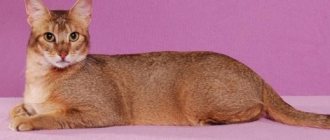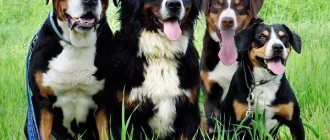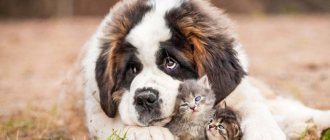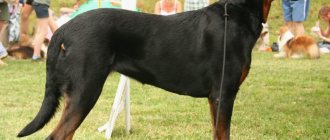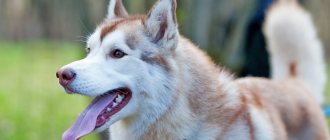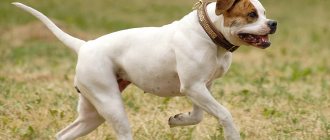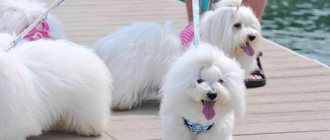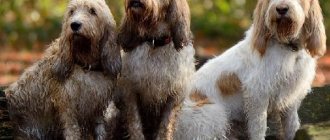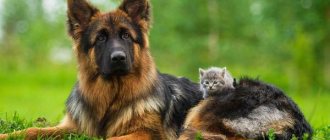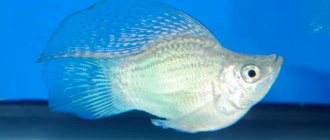History of the breed
The Celtic cat is an indigenous inhabitant of the Eurasian continent. People first noticed them more than 100 years ago. The story of their appearance has many versions. One version is its origin from Egyptian cats. The breed most likely first appeared in Scandinavia and Great Britain. The Celts were excellent hunters, so they were often kept on farms. The animals caught mice and other rodents.
The homeland of cats is Scandinavia and Great Britain
Individuals were simultaneously tamed by the Swedes, Gauls, and English, so there were 3 breeds: British Shorthair, Swedish Domestic, and Celtic. At the beginning of the 20th century, specialists from Sweden began to study them. They bred a breed called the Swiss Shorthair. Since the mid-20th century, scientists have been improving the health of the animal, and later decided to cross it with the British and Persian. The result was a Celtic (European) cat.
The resulting breed had a thick coat and a short muzzle. In addition, the Celts did not have hereditary diseases.
Scientists have identified 2 types of cats: English and Scandinavian. The British decided to crossbreed individuals with the Persians and the British to obtain a more advanced version. Scandinavians valued animals for their originality and naturalness. The cats differed from each other in appearance, but had the same name. The Scandinavians didn't like it because the breed looked different and deserved a different name.
As a result, in 1981 the FIFe registered a standard that divided the breed into Scandinavian and British. In 1982, the WCF officially gave another name - the Celtic cat.
Personality of European Shorthair cats
This breed is ideal for those looking for an affectionate and intelligent four-legged friend. When an animal finds itself in a new place for the first time, it may begin to hide. This is a natural reaction to stress from a change of environment, but it passes quickly, and in a short period the cat fully adapts to the new home.
Independence is not the main feature of this cat, but it still occurs in a few representatives. They are mostly playful and cheerful creatures. You can easily go to work, leaving your cat alone at home; it does not require much attention. Pets do an excellent job of entertaining themselves on their own and do not suffer from loneliness at all.
An amazing feature of the breed can be considered the ability to blush - this is how cats get nervous. The nose and toes become red. Along with this, they also sweat
It is very important that European Shorthairs under no circumstances rush at people or scratch themselves. They only hiss, but never bite, so for small children such an animal will be an ideal companion.
Contact and friendliness are what distinguish shorthaired Europeans. If you don't want to interact with this cat, she will never bother you. This animal delights with its easy character and tact.
Description of appearance and breed standard
Celts are powerful individuals with developed muscles. They are quite large in size and their weight can reach 8 kg. They have a wide, rounded chest and strong paws that taper at the base. Despite their stockiness, Celts are flexible and ductile.
The breed has a small rounded muzzle, the cheeks are developed and well defined, and there is a strong chin. The ears are medium in size, wide at the base but tapering and also rounded towards the tip. Some individuals may have tassels. Cats have a smooth forehead with small dark stripes, a small, smooth nose with a soft transition. Large round eyes have a uniform iris color that matches the fur coat. Most often there are individuals with amber, green, and blue eye shades. There is a small depression between the eyes. The tail is of medium length with a rounded narrow tip and a wide base.
The photo shows the appearance of the animals.
Appearance of the Celts
Description of appearance
The Celtic cat has the following description:
- massive build;
- body size is large, not compact;
- animal movements are flexible and plastic;
- moderately fluffy tail. It has a wide base. Closer to the tip, the tail tapers;
- head of oblong conical shape;
- the cheeks are clearly visible on the muzzle;
- ears are movable. They are highly placed. The auricles end with neatly rounded tips. Some individuals have unique tassels;
- the eyes are large and round. Eye color is in harmony with coat color;
- wide chest;
- strong and muscular neck;
- powerful and strong paws. They are proportional to the body. The limbs taper towards the bottom, ending in round paws.
The fur of such pets is soft and thick. It has a natural shine. These are smooth-haired animals. One of the features of this breed is the huge variety of coat colors. Due to the fact that scientists from different countries took part in the selection of the Celtic cat, the color of their fur coat became so diverse.
There are about 35 different color types in total. Often the color of the coat reflects the preferences of the people inhabiting a particular country. For example, in Germany, cats often have silver and white coats with various inclusions. In Russia, such cats have black, marbled, brindle, white, smoky, golden, red, cream and cream-striped skins.
Animals with chocolate, lilac and fawn colors in any combination are prohibited from participating in exhibitions.
Types of colors
The Celts' coat is short, soft, thick, and shiny. There are a lot of color options: black, dark brown, tabby, tortoiseshell, white, blue. The standard does not allow:
- Chocolate
- Acromelanic
- Lilac
- Red-brown
- Faun
If a cat has one of these colors, it is not a purebred, but the result of a mixture of breeds.
Dark brown celt color
How to care for Celtic cats?
These cats do not need special care. Some particularly independent representatives of the breed even like to pretend that they don’t need a person at all. Although this, of course, does not correspond to the reality of trimming your own claws, and even the smartest cat is not able to clean its ears.
There is no need to bathe Celts often: once every six months will be quite enough. If you bathe your cat more often, this can affect its appearance: the fur will become dull and brittle. But you need to brush your cat regularly.
Character and behavioral characteristics of the Celtic cat
The Celts are proud and independent. Before you get a breed, you need to prepare for the cat to become a full-fledged resident of the house. He will have his own rights and interests. Most often, Celts are calm, balanced, independent, but they can show character when they don’t like something.
The Celtic Shorthair has an excellent hunting instinct. They adopted courage, ingenuity, intelligence, and cunning from their wild ancestors. The animal loves to catch mice and rats, so it is recommended to get Celts for those who live in a private house. If there are no rodents in the apartment, the individual will create all the conditions for hunting for itself. She will try to catch a fly, bugs, and run after the shadow.
The Celts love to hunt
Cats are almost impossible to train. They are stubborn. This breed cannot be forced to do anything it does not want to do.
It is not recommended for families with small children to have a cat. Celts can play with a child for a short time, but then they get bored. Cats can be irritated by the child's intrusiveness and noise. In this case, the Celt may become aggressive. The cat will not tolerate disrespect for its person.
The Celts are accustomed to choosing one master. They treat him with special trepidation, not the same as they treat others. The cat will keep its owner company while watching TV or reading a book. Animals copy their owner’s routine, go to bed at the same time as him, and greet him home from work. But the cat will not show tenderness. This is not the kind of person who will jump into your arms so that you can caress her. Celts do not get along well with other pets and are especially aggressive towards dogs.
The Celts choose one master for themselves
Character of the breed
Due to the large discrepancy in the history of the breed and given the fact that the Celts descended from the common domestic cat, the pets have completely different temperaments, which still have common characteristics. Most often they are quiet, calm and balanced and have an unobtrusive and independent character. And from time to time, pets can show their pride and independence, and the owner will have to take this into account.
Since the ancestors of European shorthairs were wild, modern cats inherited from them courage, curiosity, intelligence and well-developed ingenuity. The animals are happy to demonstrate their hunting skills in the game. If there are no rats or mice in the house, the cat will still find objects to hunt: they can be flies, beetles or random shadows. Celtic cats treat children well and can have fun with them for a short time, but soon they get bored with noisy games and leave. But if the kids begin to allow themselves too much, the animal will not tolerate torment and will not allow any aggression towards itself.
Celtic cats are almost impossible to teach tricks and commands. And not at all because they do not have intelligence, but simply because the cat will not “dance according to orders.” This can only happen if the pet himself wishes it. Therefore, many breeders call the proud pet the only real cat.
The Celtic cat is very unpretentious. She is very attached to her owner and is ready to travel with him everywhere, because with her best friend, even in a new environment it is not scary. In addition, the Celtic cat can imitate the habits and rhythm of life of its owner. Pets love their owners intelligently and tactfully, and some distance in relationships is always felt. Therefore, most likely, relationships with them will resemble friendly and neighborly ones rather than close and related ones.
European Shorthairs are mostly silent and can only speak out in exceptional situations: when the owner forgot to feed them or someone unlucky stepped on the cat’s tail.
The Celtic cat may have a negative attitude towards its fellow cats, so it is better not to get other animals so that the situation in the house does not become tense. It’s better not to keep birds or rodents either – the cats’ hunting instincts will not leave them indifferent. They are also wary of strangers.
Contents and features of animal care
Celts do not require difficult care. You don’t need to wash them often, 2-3 times a year is enough. They wash themselves during the day. Too frequent bathing procedures can dry out the coat. You shouldn't save money. A good shampoo should not contain aggressive surfactants. 1-2 times a week you can comb the coat with a furminator or a natural bristle brush to prevent clumps from forming and the hair does not get tangled.
Celts need to be bathed 2-3 times a year
You need to clean your ears regularly to get rid of earwax and dirt buildup. Once a week you need to clean the ear canal using cotton swabs. As they become dirty, you need to disinfect your eyes with cotton swabs. A weakly concentrated solution of boric acid or herbal decoction is suitable.
To prevent the formation of tartar, you need to periodically brush your teeth with a toothbrush, a cloth wrapped around your finger, and a special tooth powder.
In order to keep the furniture intact, sometimes you need to trim the nails. However, you need to do this carefully. Choose a time when your pet is calm. Don't yell at him so he doesn't get scared.
Care and mandatory hygiene
Thanks to the outdoor past of European cats, keeping them does not require much effort or knowledge. By nature, they have a short but thick coat, on which practically no dirt remains, and pets do not like the bathing procedure. Only those representatives of the breed who regularly take part in exhibitions and competitions take water treatments using specialized shampoos. It is recommended to bathe and comb all other Celts several times a month. It is necessary to carefully examine the ears of animals for the presence of ticks. Wipe eyes and ears as they become dirty with a soft cloth, which should be moistened with warm water or cotton pads.
Celtic or European shorthair cats often take part in competitions and exhibitions in the Russian Federation.
Feeding
The Celts are unpretentious in food. It is important to choose the type of food: natural food or dry food. The diet may include boiled meat, vegetables, soups, cereals and dairy products. You should not give Celts fatty, spicy, sweet, fried foods. This can obstruct your digestive tract. Dry food is a good way to feed your pet. They are a complete diet for cats. It is important to maintain water balance and replenish the bowl with fresh water in a timely manner.
Nutrition of the Celts
Feeding cats
Starting from the age of three weeks, kittens need clean water, which is placed at several points around the room so that the kids do not forget to drink. The best option is to get a fountain that will always provide clean, oxygenated drink.
Table 2. Approximate diet for kittens.
Age of the kittenProductsDaily feeding frequency
| From 1 month |
| 5–6 times |
| From 2 months |
| 5–6 times, increasing portions |
| From 3 months | Finally transferred to food for adult cats | up to 4 times |
After the second month of life, kittens can be switched to professional food - dry and wet.
The following are prohibited at any age:
- animal fats, especially rendered;
- pork;
- fried, fatty, smoked;
- sweet and salty;
- dishes from the host's table.
Delicacies from the master's table are prohibited
The cat remains playful and in a good mood only if it receives enough quality food. The diet of adult cats must include the following products:
- lean poultry, beef, veal, freed from bones and sinews;
- cereals (rice, buckwheat) - up to 20%;
- chicken liver, beef heart (once a week);
- stewed vegetables (zucchini, cauliflower and white cabbage), greens (spinach, lettuce);
- sea fish - preferably cod, haddock (no more than once every 7 days);
- cottage cheese with a fat content of up to 9%, three-day kefir (fresh causes digestive disorders).
The meat is boiled, cut into fingernail-sized cubes, and mixed with grains and vegetables. Olive oil and a little bran are also added there. It is believed that the best product for cats is chicken. But this is not true, it does not contain enough amino acids and nutrients. Therefore, you should not feed cats exclusively this type of meat. It is better not to offer milk to cats: it can cause loose stools. Not every cat's body has the enzymes necessary to digest this product.
It is better not to include milk in the diet
The wool will tell you whether the diet is correct. If it is shiny and soft, then there are enough nutrients. If you have problems with the skin, you should contact your veterinarian. He will determine the cause and, in case of vitamin deficiency, prescribe appropriate medications. In any case, with a natural feeding method, it is necessary to constantly or periodically add vitamin supplements to the food.
Vitamin and mineral complex Radostin
However, experienced cat breeders increasingly prefer ready-made dry and canned food. Products in the super premium class category are produced under the trademarks ProNature Holistic, Royal Canin, Sanabelle.
Experienced breeders often prefer ready-made food
New products are presented in the holistic segment. These products are chosen by professional nurseries. Unique technologies for processing meat and vegetables suitable for human consumption are used. These include Orijen, Wellness and Natural{amp}amp;Delicious.
However, the economy class segment also offers decent products, which are also characterized by a balanced set of nutrients, vitamins and minerals. These are Josera, Belcando, Advance. They can often offer treatment lines for cats with special body needs.
When feeding these animals, the owner will also not have any problems, since they are unpretentious and undemanding in choosing food. Pets will happily eat both dry food and natural food.
We suggest you read: What to do if your cat has spots on his ears
If the owner prefers natural food, then he should remember that Europeans are carnivores by nature, so their menu must include meat and offal. You can diversify their diet with various cereals, vegetables and dairy products.
Archaeologists consider the Celts to be a mysterious people. Their food preferences are puzzling. The Celts who lived in Ireland did not cook dishes from crane, the British Celts refused to eat chicken and hare, but our Celtic cat is of European origin, which means she does not have any strange food taboos.
You can feed your European cat both natural food and prepared food. The main thing is not to be greedy in portion sizes and remember that the menu should contain at least 30% pure meat (not offal)!
Milk, raw fish and confectionery are foods that should not be given to cats in principle!
Archaeological scientists believe that the Celts were a rather mysterious people. And their eating habits cannot but surprise them. For example, the Irish Celts never ate crane meat, and the Celts from Britain did not eat chicken or hare meat. However, Celtic cats are still European by blood, so they do not have any dietary restrictions.
The animal can be fed with both ready-made store-bought food and natural food. The most important thing is not to limit portion sizes and not to forget that meat in the diet of a European Shorthair should be at least 30%. Moreover, we are talking about pure meat, and not offal: the cat will not consider them meat.
Cost of a kitten
The breed is not common in the CIS countries, so it is not easy to buy a Celtic kitten. Officially, there are no nurseries where the breed is bred and sold. Celts can be found from private breeders. The average cost of a pet is from 2 to 15 thousand rubles, and abroad at least 30 thousand. To avoid falling for scammers, it is better to buy Celts from officially registered breeders who cooperate with worldwide associations. It is also worth asking for documentation and information about the pedigree.
The price of a Celtic cat kitten is from 2 to 15 thousand
Health
Representatives of the Celtic cat breed never suffer from inherited diseases. And they can be protected from infectious diseases through timely vaccination.
Young kittens should receive their first vaccinations at 8-12 weeks of age. At the same time, at 12 weeks, vaccinations are done if the mother of the kittens has been vaccinated, and at 8 weeks - if the cat is not vaccinated. Kittens' teeth change at four months of age, and this process ends at seven months. Animals cannot be vaccinated while they are changing teeth.
It is mandatory to vaccinate cats: otherwise, the pet may die before the time allotted by nature. Symptoms of health problems in European Shorthair cats include refusal to eat, inactivity and photophobia. If you notice such manifestations in your animal, you should immediately contact your veterinarian.
The average lifespan of Celts ranges from 15 to 17 years.
These cats have been fighting for existence for many centuries, so they have very strong and resilient health. They are not prone to any genetic or hereditary diseases. But experts still recommend regularly visiting a veterinarian with your pet and giving him all the standard vaccinations, especially if he roams freely on the street.
Celts do not have hereditary genetic diseases! To prevent them from suffering from other cat diseases, cats of this breed must undergo mandatory vaccination. After all, even if the animal does not leave the apartment, it is still exposed to the danger that we bring from the street on our shoes or dirty hands.
IMPORTANT! Kittens are given their first vaccines at 8-12 weeks of age. After a while, revaccination is required. 8 weeks of age is optimal if the mother cat has not been vaccinated; 12 weeks of age is suitable for vaccination if the mother has all vaccinations.
The change of teeth in a kitten begins at 4 months and lasts until 7 months of age. Vaccinations are not recommended at this time.
If vaccinations are being done for the first time, then congratulations - the Celt will receive a passport!
And, of course, do not forget that 10 days before the first vaccinations, your pet needs to be dewormed and get rid of fleas.
After vaccination, monitor the health of your European Shorthair. How can you tell if something has gone wrong? Lethargy, refusal to eat, photophobia are symptoms that should promptly consult a veterinarian.
Today, pet vaccination is mandatory. After all, the price of doubt is the life of your cat.
The lifespan of a European shorthair cat is 15 – 17 years.
The good immunity of representatives of the European breed is explained simply by the relationship between genetics and health. It is enough to remember from what breed they were bred. These are ordinary yard cats that could adapt to different conditions and places of residence, getting their own food by hunting small animals.
European shorthair cat

